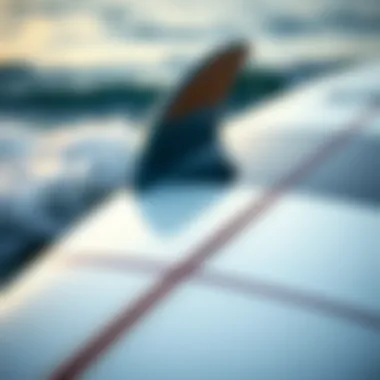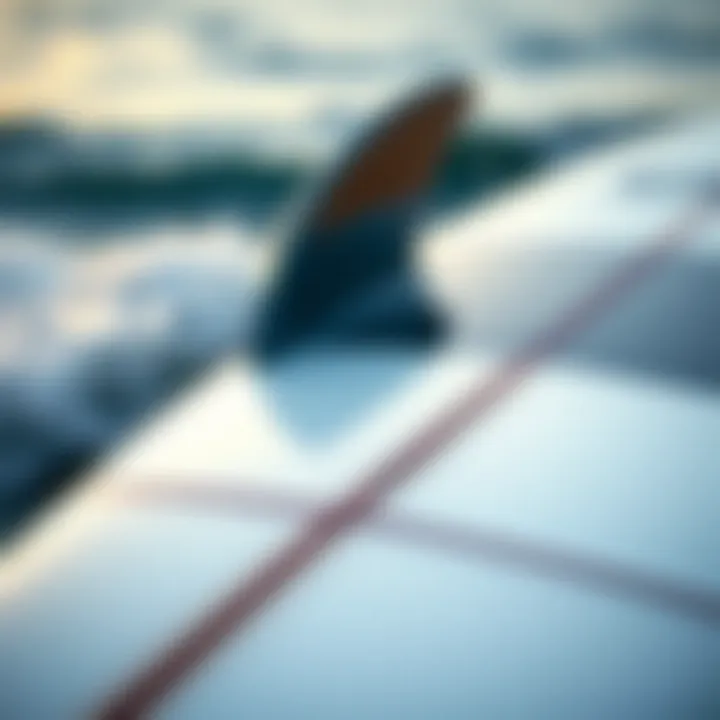Choosing the Right Size Fish Surfboard for Optimal Fun


Intro
Selecting the right size fish surfboard isn't just about picking an attractive board; it's a fundamental element that can make or break your time on the waves. For surf enthusiasts—whether seasoned veterans or enthusiastic beginners—understanding how different board sizes cater to various skill levels and water conditions can enhance overall performance. This guide aims to demystify the selection process, addressing key factors that impact your surfing experience, such as personal preferences, wave types, and skill levels.
The fish surfboard style, with its distinctive shape and buoyancy, offers unique performance advantages that can be maximized through correct sizing. By diving into this article, you'll come away equipped with the knowledge to choose a board that aligns seamlessly with your surfing aspirations.
Surfing Techniques
Understanding the size and design of your fish surfboard can refine your surfing techniques considerably. Whether you're mastering the basics or pushing the envelope with high-level maneuvers, the right board makes a noticeable difference.
Mastering the Basics
The foundational skills of surfing often hinge on having the right equipment. A fish surfboard generally features a wider nose and a flatter tail, which provides ample stability. For novices, selecting a slightly larger board can create a forgiving platform that eases the learning curve.
- Paddling: A wider surfboard allows for easier paddling, which is essential for catching waves more effectively.
- Balancing: A longer fish surfboard enhances balance, making it easier for beginners to stand up on their first attempts.
Additionally, opting for a board that is taller than your own height can help generate momentum needed for riding waves.
Advanced Maneuvers
For the more experienced surfers out there, a properly sized fish surfboard allows one to hone complex skills. The right board can provide the agility needed to execute advanced maneuvers, such as cutbacks and aerials.
- Wave Selection: A shorter board might excel in tighter, steeper waves, offering sharper turn capabilities.
- Speed Control: Proper sizing contributes to improved speed management, which is crucial for performing tricks.
An oversized board may hinder your maneuverability in critical situations, so consider evaluating your experience level dynamically with the various strengths of the fish surfboard.
"Choosing the right surfboard size bridges the gap between skill and enjoyment; it fosters gradual progression and boosts confidence in the water."
Surfing Lifestyle
Beyond the mechanics of riding the waves, the surfing lifestyle incorporates a philosophy and a sense of belonging to a community. Understanding this culture can further enrich your surfing experience, leading you to discover sustainable practices and appreciate the diverse worldwide surf culture.
Sustainable Surfing Practices
- Recycled Materials: Look for boards made of recycled foam or reclaimed surfboards.
- Local Manufacturers: Supporting local artisans not only reduces carbon footprint but also strengthens community ties within the surfing world.
Surf Culture Around the World
The joy of surfing transcends borders, with distinct surfing cultures flourishing across different regions.
- Hawaii: Often considered the birthplace of surfing, where the culture runs deep and traditions are respected.
- Australia: Famous for its competitive yet welcoming surf community, blending casual beach life with adrenaline.
- California: An epicenter of surf innovation and lifestyle, attracting enthusiasts from all walks of life.
Understanding Fish Surfboards
Definition and Characteristics
Fish surfboards offer a unique blend of performance and style, setting them apart in the surfing world. Characterized by their wide tail and pointed nose, these boards are designed to glide over smaller waves, making them perfect for surfers who enjoy cruising on mellow swells. The flatter rocker curve aids in speed, while the extra width provides stability. In essence, a fish surfboard allows you to catch waves with ease and maintain momentum, giving a more forgiving ride, especially for those still getting the hang of things.
As these boards cater to a range of surfing styles, they work well for not just casual surfers but also for those looking to push boundaries in terms of creativity. Utilizing a fish surfboard means embracing a variety of techniques—think fast turns and sharp angles—that can elevate one’s surfing experience to new heights.
Typical Dimensions


When it comes to sizing, fish surfboards generally range between 5 feet and 7 feet in length. Their width typically falls around 20 to 24 inches, and the thickness is often about 2.5 to 3 inches. These dimensions are tailored to maximize buoyancy while enabling smoother maneuvers in smaller waves. However, dimensions can vary based on specific models and the surfer’s preferences.
The overall shape is also crucial. For instance, boards with more significant volume are beneficial for beginners, as they provide extra stability. Conversely, experienced surfers may gravitate towards slightly narrower width and less volume to enhance responsiveness.
"Getting the right dimensions in a fish surfboard can greatly impact performance—there's a fine line between stability and responsiveness."
Comparing Fish Boards to Other Types
Fish surfboards differ markedly from traditional shortboards and longer longboards, each serving distinct surfing purposes. Shortboards, while more agile, can be less forgiving for those still learning the ropes. Longboards, on the other hand, are great for stability but may lack the quick, sharp turns that fish boards offer.
By comparing these types:
- Fish Boards: Ideal for small- to medium-sized waves, great for quick maneuvers and stability.
- Shortboards: Best for high-performance surfing, requiring more skill and energy to ride effectively.
- Longboards: Excellent for catching waves early and cruising but lacks the versatility found in fish boards.
Ultimately, understanding these differences is crucial for anyone looking to make an informed decision about which board aligns with their surfing goals. Choosing a fish surfboard means selecting a vessel crafted for fun, joy, and ease on the water, all while staying stylish.
Factors Influencing Size Choice
Understanding the various factors that play a role in selecting the right size fish surfboard is crucial for ensuring a fulfilling surfing experience. Making the right choice can dramatically impact not only performance but also enjoyment on the waves. The size of a surfboard can often feel like a never-ending puzzle, one that requires a deep dive into personal attributes, environmental conditions, and riding styles. By closely examining these elements, surfers can pinpoint what works best for them.
Skill Level Considerations
Beginners
For those just starting out, the transition to surfing can be daunting. The specific aspect concerning beginners often revolves around stability and ease of paddling. Generally, beginners tend to opt for wider boards as they provide a more stable platform, which is essential for learning. The key characteristic here is the need for balance—beginners benefit from a fish surfboard's inherent buoyancy, making it easier to catch waves. This type of board encourages confidence-building as they can withstand various conditions without being overly challenging. However, it's worth mentioning that a board that’s too large can be restrictive when a beginner seeks to maneuver as they become more skilled.
Intermediate Surfers
Moving into the intermediate realm, the focus shifts a bit. Surfers at this level often seek a balance between stability and agility. Intermediate surfers may start experimenting with smaller fish boards that allow for tighter turns and more responsiveness. The unique feature of this group lies in their variety of riding styles; for them, surfboards ought to reflect individual taste while still catering to their advancing skills. It becomes a steeper learning curve when choosing sizes, as selecting a board that’s either too small or too large can lead to inconsistency. Thus, intermediate surfers should consider the specific waves they typically ride while making selections.
Advanced Surfers
For advanced surfers, the conversation often steers into performance, wherein the significance of size becomes intricately tied to personal performance metrics. Advanced surfers have a refined skill set that allows them to exploit the unique features of smaller fish boards. What sets this group apart is their ability to handle high speeds and sharp turns with finesse. While a smaller board may offer less paddle power, the immediate feedback and control can lead to exhilarating rides. Nevertheless, the downside of a smaller board is a decreased margin for error, which can be particularly challenging in rough ocean conditions.
Wave Height and Conditions
Small Waves
When it comes to small waves, the riding experience can greatly dictate the board's size. The key characteristic of surfing in small conditions is the reliance on the board's speed and maneuverability. In this scenario, fish surfboards are often favored as they maintain momentum, allowing surfers to ride even the most gentle swells. A smaller board can indeed provide the joy of smooth, flowing rides. However, it might feel a bit wobbly in these types of waves for a novice who might lack experience in adjusting for subtle wave shifts.
Medium Waves
As waves grow in height to a medium range, a board's dimensions should adapt accordingly. Fish surfboards in this category are designed for versatility; they can handle a variety of conditions without compromising performance. The unique aspect here is that medium waves can vary significantly, making it crucial for surfers to find the right balance of size. While a board can enhance performance, if it's not sized correctly, it can lead to either catching too few waves or experiencing difficulties in keeping pace with faster currents. It truly becomes a dance with the sea.
Large Waves
Surfing in larger waves presents its own set of complexities. The specific aspects to consider in this situation hinge on responsiveness and stability. Large waves require a fish surfboard that provides enough volume and strength, ensuring that it can handle powerful swells. For advanced surfers, a fish board could be tailored to these conditions, providing agility while still offering enough foundation for stability. However, the unique feature of choosing a board for large waves includes the varying safety concerns; a poorly sized board can lead to dangerous wipeouts or difficulties in turning.
Personal Preference and Style
Riding Style


Understanding one's riding style is pivotal when selecting a suitable fish surfboard size. Each surfer has a unique flair, and the board’s size should align with the riding preferences. From high-speed rides to smooth, flowing turns, each approach benefits from a specific board dimension. The key takeaway here is that a surfer's style directly impacts how they engage with the board. If one feels constrained on a particular board, their confidence and enjoyment in the water will likely diminish, making it essential to find a comfortable fit.
Shortboard vs. Fish
The comparison between shortboards and fish boards fundamentally illustrates the nuances of surfing preferences. While shortboards emphasize speed and radical maneuvers, fish boards cater to controlled, fluid rides and glide over the water with ease. One characteristic that highlights fish boards is their wider design, providing increased stability. However, surfers who thrive on quick, nimble turns may find shortboards better suited for their thrill-seeking nature. This decision can often boil down to what type of waves are most commonly ridden, and the surfer's personal aspiration in their overall experience.
Fish Surfboard Sizing Guide
General Sizing Recommendations
When it comes to selecting the size of a fish surfboard, there are some general guidelines that surfers can operate within. The size of the board can effectively cater to your skill level, personal preference, and the conditions you anticipate riding. As a rule of thumb, many surfers find that a fish board should be around 5 to 7 inches taller than their height. This is a starting point, and many pros or seasoned riders may deviate a bit more based on their unique riding style.
- Beginner Surfers: For those just starting out, it's often recommended to lean towards a longer board. A longer board provides extra stability and paddling ease.
- Intermediate Surfers: These surfers may want to narrow down their choices a bit, seeking something that allows for quicker maneuvers without sacrificing too much stability.
- Advanced Surfers: Those who have honed their skills generally prefer shorter boards. They often favor a size that complements their need for speed and tight turns.
Choosing your size is about balancing stability with maneuverability. Too big might feel sluggish, while too small could lead to instability.
Height and Weight Metrics
Understanding how your height and weight play into the selection of a fish surfboard is paramount. Generally, your weight has a direct correlation with the volume of the board. The heavier you are, the more volume you might need for buoyancy.
- Height Considerations: While height can guide you in sizing up the board, consider your skill level and surfing style. For someone shorter, a smaller board might still perform adequately, but it can be tricky.
- Weight Recommendations: A board's volume often needs to match your body weight. If you fall within the range of around 110 to 150 pounds, consider boards with a volume of about 30 to 35 liters. If you are heavier, like 190 to 220 pounds, aim for around 40 to 50 liters.
Measuring these attributes is essential for getting the best fit. Boards that don’t align with your metrics will often lead to disappointing sessions.
Volume and Its Importance
Volume is one of the most critical metrics for sizing your fish surfboard. The volume of a board is simply the amount of foam it contains, generally measured in liters. This metric determines the buoyancy of the board in water.
- Buoyancy: More volume means more buoyancy. This is critical for less experienced surfers or heavier individuals. They will find it easier to paddle and catch waves with a more buoyant board.
- Performance: Conversely, less volume can lead to enhanced agility which is usually sought out by more adept surfers. They might want quicker response times and more sharp turns, so keeping the volume lower suits their needs.
Ultimately, being aware of how volume interacts with your height, weight, and skill level is essential for making an informed decision when choosing a fish surfboard.
"A well-sized board is like a well-fitting suit; it enhances performance and enjoyment."
Trial and Error in Choosing Size
When it comes to finding the right size for a fish surfboard, sometimes the best way to learn is through a little ol’ trial and error. Each surfer is unique, and surfing conditions are as varied as the number of waves in the ocean. So, dabbling with different boards might just be what you need to discover what feels best under your feet.
Testing Different Sizes
You might get tempted to stick to recommendations or even to buy based solely on online reviews. However, picking a fish board isn’t as straightforward as choosing a size off a rack. Most surfers find value in trying different lengths, widths, and shapes. Why? Because one surfer's sweet spot might not resonate with another's experience. Experimenting with boards of varying size helps surfers develop intuition about how the board reacts to their weight, skill level, and riding style.
- Longer Boards: Generally provide more stability, suited for cruising.
- Shorter Boards: Offer increased maneuverability, ideal for sharper turns.
Short-finned fish surfboards, for instance, feel quite different from longer, twin-finned ones. Testing a few options can broaden your understanding of balance and control crucial to improving your wave-riding skills.
The Role of Rentals
Sometimes, taking the plunge into a purchase can be daunting. Enter surfboard rentals. Many surf shops or rental services have a range of fish boards available, allowing surfers to test various sizes without making a long-term commitment. This approach is especially useful when traveling, where wave conditions can differ drastically from local spots. Renting a board lets you adjust your choice based on how different sizes perform in real-time conditions. Moreover, some rental services offer local knowledge about which boards work best in specific surf spots.
- Flexibility in Choices: Renting allows you to swap boards day by day if need be.
- Cost-effective Experimentation: You don’t have to break the bank trying to find the right fit.


Feedback from Experienced Surfers
Don't underestimate the value of insights from seasoned surfers. Their feedback can be like gold nuggets in the vast sea of surfing knowledge. Discussing with fellow surfers about your experiences can help in determining what size might work best for you. Join local surf communities, forums, or social media groups where experienced surfers share their stories. When you ask them, they may offer vital tips or vital specs on board sizes rooted in their own adventures.
*"Every surfer has their own tales and preferences. Listen closely—there’s always something new to learn."
- Local Surf Shops: Often the nexus of the surfing community; staff typically have a wealth of knowledge.
- Communities Like Reddit or Facebook Groups: Great places to read reviews and post inquiries about size experiences.
Maintaining Your Fish Surfboard
When it comes to enhancing your surfing experience, maintaining your fish surfboard is of utmost importance. Just like any piece of sports equipment, a well-cared-for board can drastically affect performance, durability, and even your enjoyment of the waves. Whether you’re a seasoned surfer or just starting out, understanding how to care for your fish surfboard can save you both time and money down the line, not to mention ensuring you always have a reliable board beneath your feet.
Regular Maintenance Practices
Regular maintenance practices are essential to keep your fish surfboard in peak condition. Here are some straightforward steps to consider:
- Rinsing After Use: Always rinse your surfboard with fresh water after a surf session. Salty water can lead to corrosion and degradation of materials over time.
- Drying Thoroughly: Place your board in a shaded area to air dry. Direct sunlight can warp the foam, while proper drying prevents mold and mildew.
- Check Fins and Leash: Regularly inspect your fins and leash for wear and tear. A loose fin can drastically affect your ride, while a faulty leash can result in losing your board when you wipe out.
These practices not only extend the lifespan of your surfboard but also improve its responsiveness and handling on waves.
Repairing Minor Damage
Minor damage is almost inevitable, but addressing it promptly can prevent bigger problems. Here’s what you should keep in mind:
- Identifying Damage: Look for dings, cracks, or dents in your board. If you spot any, it’s crucial to tackle them before they worsen. Catching these early means avoiding costly repairs later on.
- Repair Kits: A simple repair kit tailored for surfboards can work wonders. These typically include epoxy resin, sandpaper, and a mixing stick. To use, clean the damaged area, mix the resin thoroughly, apply it, and sand it down when it cures.
- Professional Help: For significant damage, don't hesitate to seek professional repair services. An experienced surfboard technician will ensure your board is fixed correctly and safely.
Even the smallest repairs can make a major difference in maintaining performance and safety in the water.
Storage Tips for Longevity
How you store your fish surfboard can also impact its lifespan. Here are some tips to help it last:
- Keep It Cool: Store your board in a cool, dry place. Extreme temperatures can warp and degrade materials, so avoid leaving it in direct sunlight or extreme heat.
- Use a Board Bag: Investing in a quality board bag can offer protection against scratches and dings, as well as UV damage.
- Avoid Stacking: If storing multiple boards, avoid stacking them directly. Use vertical storage solutions or wall racks to prevent unnecessary pressure or weight on your boards.
Proper storage can effectively shield your board from damage and ensure it remains ready to hit the waves whenever you are.
The Future of Fish Surfboards
As surfing continually evolves, so too does the fish surfboard. Understanding the future of these boards is essential for surfers looking to enhance their experience in the water. From technological advancements to greater attention on sustainability, the development of fish surfboards reflects broader trends within the surfing community and the world at large. The ongoing changes not only impact performance but also influence how surfers connect with their environment.
Evolving Designs and Technologies
Innovation is at the heart of the future of fish surfboards. Board manufacturers are tirelessly experimenting with new materials and designs that push the envelope of performance. A notable trend is the integration of technology into surfboard construction. For instance, many brands are incorporating lightweight composites that offer greater buoyancy and durability without sacrificing performance.
Moreover, advancements in hydrodynamic design improve the board's ability to glide easily on waves, which can particularly benefit surfers in diverse conditions. Some companies are even exploring the use of smart technology, such as embedded sensors to track performance metrics. This data-driven approach can help surfers continuously refine their technique and overall enjoyment of the sport.
Sustainability in Surfboard Manufacturing
In a world increasingly conscious of environmental issues, sustainability in surfboard manufacturing is becoming paramount. Traditional methods often involve materials that are harmful to the environment, but many companies are shifting to more sustainable practices. Options such as bio-based resins and recycled materials are gaining traction. By sourcing eco-friendly products, manufacturers not only reduce their carbon footprint but also appeal to a growing demographic that prioritizes green products.
Surfers are also becoming advocates for sustainability, often supporting brands that align with their values. This shift has led to a heightened awareness among consumers. It's important to remember that every surfboard’s lifecycle is interlinked with the health of marine ecosystems. By investing in sustainable boards, surfers contribute to the preservation of the environments where they ride.
Community Trends and Insights
The future of fish surfboards signals a shift influenced by community trends and insights. Local surf cultures are playing a vital role in this progression, as riders share their preferences and experiences through social media platforms like Reddit and Facebook. Online communities make it easier for surfers to exchange ideas about the latest gear, what��’s working for them, and what’s not.
"The best surfboards are a reflection of a community's values and its ongoing dialogue with the ocean."
This interconnectedness fosters a sense of belonging and accountability among surfers. As new brands emerge, many are incorporating feedback directly from the community, creating products that resonate more profoundly with riders. This grassroots approach not only enhances board performance but also ensures that surfers feel a personal connection to the products they choose.















